Is it necessary to cover thuja for the winter?
If a tree is covered with snow, the needles will rot and the crown may become deformed. On days when the bright sun shines and the air warms up, the plant is at risk of sunburn. Under the sun's rays, the crown and trunk of the tree heat up, while the root system is at rest. If you do not cover the thuja for the winter:
- the crown will turn yellow;
- the needles will dry out and fall off;
- possible curvature of shoots;
- a young plant may break under the weight of snow.
Ultraviolet radiation has a negative effect on needles. Therefore, it is recommended to cover all types of thuja. Young trees are covered with a crown and root system. For mature plants, it is enough to protect only the top. If you properly winterize the thuja, the tree will maintain its health and beauty.
Types of the most common mistakes
Inexperienced gardeners who have never encountered growing crops immediately make many mistakes. As a result, the tree cannot tolerate them and over time either dries out or rots. Here are options for the most common mistakes from agricultural practice:
- for the winter, the crowns of young trees are left uncovered;
- use fertilizers that are intended for deciduous trees (nitrogen complexes);
- do not cover the needles with sun screens;
- the shelter is removed too early.
An important step in the development of a tree is the formation of the crown. If it is not planted correctly, the plant immediately loses its appearance. Therefore, after the shelter is removed, the thuja needs to be trimmed. For pruning, take pruning shears, they are convenient to work with. First of all, remove dry and diseased branches with yellow needles from the top and middle part of the tree, they are already dead. If the crown is excessively thick, thin it out a little. This will increase the breathability of the tree and also reduce the risk of pest attack on the crop. In order for your thuja to grow better not up, but in width, cut off part of the top; trimming the top helps stimulate the side shoots, they become more active. There are 3 types of thuja pruning:
- spiral The most common form for pruning thuja. in general, the tree resembles a large cone, its top will be narrowed;
- spherical. This option is suitable for forming low crowns. The plant looks great on a summer cottage, in a winter garden;
- topiary The crown is formed in the form of any geometric figure: rhombus, square, ball. Garden stores sell metal frame molds for laying the crown, according to which they subsequently perform pruning.
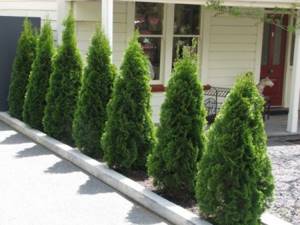
Thuja will be the main decoration of your local area if you care for it correctly: protect it from the cold outside, trim the crown, and water it regularly. A healthy and beautiful tree pleases the eye and attracts the attention of everyone around. Thuja can live for decades, no matter what region you plant it in, so if you love evergreens, then the choice for planting is obvious.

Beautiful and graceful coniferous trees - thuja - withstand frost and are unpretentious in care. However, some varieties, such as oriental ones, need additional protection in winter. In addition, young trees can be damaged by snowfall and gusty winds and suffer from direct sunlight. In this regard, wintering thuja requires a separate discussion.
Read also: How to make a drinking bowl for broilers with your own hands
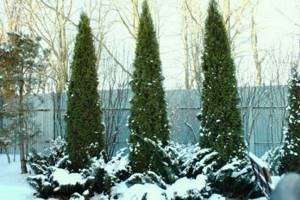
Time frame for creating a shelter
Thuja must be insulated in the fall, before the onset of the first persistent frosts. The time frame for creating protection is approximate. It is necessary to focus on the long-term weather forecast. In order for the tree to better survive the winter, you need to have time to prune, water and fertilize before the first frost.
Volga region
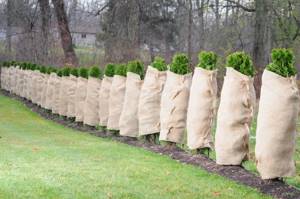
The region includes 6 regions, within which the climate differs significantly. In Astrakhan, where the climate is arid and warm, thuja is protected only from sunburn. In other regions (Samara, Ulyanovsk), the approximate time frame for creating a shelter is from the second half of September to October.
Ural and Siberia
In the northern regions of the country, winter comes early; by October there may be severe frosts. The shelter must be done before the end of the first month of autumn.
Middle lane
In Moscow, the Moscow region and the Leningrad region and other regions of central Russia, thujas are covered from the second half of October to November. Some gardeners insulate trees as frost sets in. If the winter is expected to be warm, you can cover the tree to prevent sunburn in early spring.
Covering the root system

For the winter it is necessary to insulate the tree trunk circle. Use one of the options:
- A mixture of fallen leaves with soil - the material will insulate the roots and retain moisture in the soil. In spring, the foliage will rot and act as fertilizer.
- Mulching with loose high peat.
- Wood sawdust.
- Reeds.
- Agrofibre or spunbond.
Important! Another option for insulating the root system is a mixture of fallen leaves, compost, peat, bird droppings, straw and topsoil from a coniferous forest. The ingredients are taken in equal parts.
In Siberian conditions, spruce or pine spruce branches are placed on top of a layer of organic matter or agrofibre. Insulation of the root system of young plants is especially important. The roots of the seedlings are still undeveloped and may freeze in winter. You can also use gauze as insulation - the material ensures free air circulation, eliminating overheating of the root system.
Root protection
The root system of cypress is superficial, therefore, like the crown of the plant, it requires protection, especially in dry and frosty winters. You need to start insulating the roots by removing all the weeds that grow around the crown.
For better wintering, in August, autumn fertilizer with a high content of potassium and phosphorus is scattered around the tree trunk. And the root area of the thuja is dug up very carefully, since its roots are located close to the soil surface. This treatment of the root system will allow the plant to safely endure the winter cold and awaken in the spring.
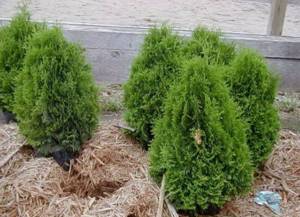
Using granular fertilizer is very convenient because it dissolves when it gets wet. If you water the thuja yourself, then you need to control the degree of soil moisture. To test the soil for moisture content, simply take a small lump of earth and try to squeeze it. If, after unclenching the palm, the soil has a crumbly shape, then the plant needs additional moisture.
Choosing a covering material for the crown
To cover the crown, both purchased materials (agroterm, spunbond, lutrasil) and improvised materials are suitable. What covering material can be used for thujas:
- Cotton or chintz sheet.
- Gauze - a piece of material must be at least 0.5 m thick. The fabric is cut into strips that are longer than the height of the tree. The strips are fixed on the top and sides.
- Sugar bags - first you need to remove the plastic strip.
- Craft paper - wood is wrapped from the top down in a spiral.
Important! To secure materials, use twine, a stapler or thread.
If you plan to install a frame, you will need metal corners, wooden supports, wire, beams, fasteners, etc. Before insulation, the tree crown must be cleared of diseased and damaged branches. Keep in mind that during wintering the crown of some types of thuja changes color from green to bronze. The change in color is due to the varietal characteristics of the plants.
Plant protection
During rest, the crown of the thuja is exposed to low temperatures, bright sunlight and heavy snow cover. In this regard, weak and immature coniferous trees need additional protection and shelter for the winter.
Covering materials and features of their use
If you have a small thuja growing, then you can use improvised means, for example, a plastic bottle, to cover it. However, this option is not suitable for large plants, and here it is important to determine what materials can be used, their advantages and disadvantages.
Before covering the thuja, it is necessary to protect the crown from falling apart, especially if the plant consists of several trunks or has a spherical shape. To do this, use a rope made of natural fibers. They tie it around the lower part of the trunk and gradually wrap it around the entire crown of the coniferous plant using spiral movements. In this way, you can strengthen the crown of both small and large plants. If it is not possible to tie a tall thuja completely, then you can do it to the height of your height.
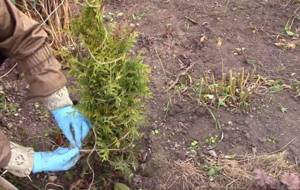
Cover the crown with:
- nonwoven materials, for example, agrofibre, lutrasil, spunbond, agrospan;

- gauze;
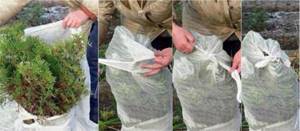
- burlap;

- kraft paper.

The choice of nonwoven material must be approached very seriously. The material must be chosen thin enough so that the plant can breathe well, therefore, polyethylene is not used to cover the thuja. Using a stapler, bag-like covers are formed from the material according to the size and shape of the plant. Modern manufacturers have already solved the problem of forming such covers, so there is a wide range of thuja covers made from such materials on sale.
Another material for crown protection can be kraft paper. They start wrapping the crown from the top and spiral down to the base. Such material must be overlapped, and fixation is carried out using a stapler and rope.
Frame
Frame structures are used to insulate young plants. You can make them yourself or purchase ready-made options. To form a frame support at home, you will need thick slats, bars, thin plastic tubes, wire and metal corners.
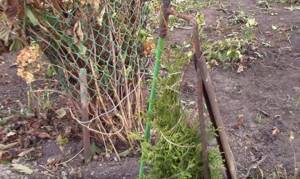
For small-sized thujas, structures with three supports are used; for larger plants with a spreading crown, structures with 4 supports are used. The length of the frame leg should be at least 2/3 of the height of the thuja, and for better fixation they are driven into the ground to a depth of 20 cm. If there is enough material, a structure can be made taking into account the capture of the crown top. Crossbars and connecting posts are used to secure the material.
A cover made of protective material, for example, an agrofibre cover, is put on the frame. It is pulled onto the frame, and the fastenings are fixed to the horizontal planks and the bases of the racks.
When using a spherical structure made of thin pipes, the upper part is fixed with twine, wire or a cross connection (for a structure made of metal-plastic pipes). This shape of the frame facilitates the rolling of snowdrifts.

If you don’t have enough time to create a frame, you can purchase ready-made structures in specialized stores. There you can choose a frame of the desired shape and from any material. The frame design allows you to protect the plant not only from large amounts of precipitation, but also protects the roots well from freezing.
Tree covering methods
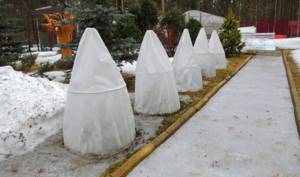
The main requirements for covering a thuja for the winter are protection from ultraviolet radiation, winds and severe frosts. The shelter does not have to be warm - you can use any fabric that allows air to pass through. It is not recommended to cover the roots and crown with roofing felt, polyethylene and other materials in which the thuja will ripen.
Sun protection material
To protect against ultraviolet rays, you can use a screen made of plywood or boards. Another option is to install 2 pegs and stretch sun protection material over them.
Important! The drug Purshate was created in America. After spraying, a protective layer is formed on the needles, which protects the plant from ultraviolet radiation.
Using a frame
The method is suitable for small thujas and medium-sized trees. Instructions with photos for installing the frame:
- Secure the branches of the coniferous tree. It is undesirable to pull the branches tightly - the air will not circulate well, and the plant will first trample and then freeze.
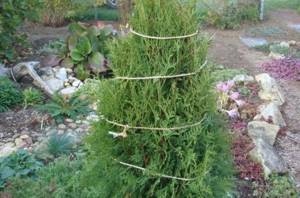
- Install several supports around the perimeter of the seedling; at the top they should connect at one point.

- Insulate the top of the structure with covering material: gauze, burlap or any other fabric. It is not recommended to use blankets or plastic film - the wood will rot.
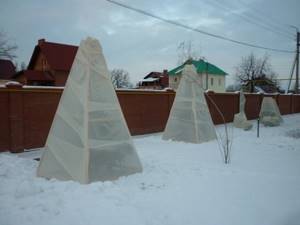
Creating a frame does not require significant financial and labor costs. In this case, the plant will be reliably protected from winter cold. You can also purchase a protective frame in the store.
Tying in a circle
The procedure will require wrapping paper, gauze or burlap. The branches need to be folded compactly and not tightly wrapped with rope. Wrap the pine needles on top with covering material. The fabric can be sewn or secured with a stapler. When making a cover, keep in mind that when wet, the fabric will shrink - make a small margin of 1-1.5 cm.
Using ready-made covers

Ready-made covers of different sizes are available for sale. They protect the tree from frost and sunlight. There is no need to erect or tie anything down—the covers just need to be placed on the tree.
Construction of a frame for sheltering a thuja
This method is unlikely to be suitable for tall trees.
But for a medium-sized plant it is quite acceptable. If you wish, you can make such a shelter yourself. For example, drive several long sticks or twigs around the circumference of a tree. On top of the thuja they can be tied together. After this, the material is pulled onto the base . First, the branches of the bush must be tied with a rope, but not tightly. Shelter in the form of a hut is good because snow will not accumulate on the surface.
To protect young plants from strong wind so that it does not damage the crowns, you can dig a pole or stake parallel to the trunk and carefully tie the tree to it. The frame, although a rather labor-intensive structure, will reliably protect the plant from wind, frost and burns.
It is not necessary to make a shelter yourself; you can buy a ready-made structure in a store. You should not throw snow on top of the thuja shelter, otherwise the needles may get stuck. For the same reason, it is not advisable to use polyethylene or blankets as shelter.
Useful tips
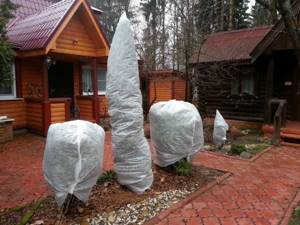
In winter, during heavy snowfalls, remove snow from the branches. It is advisable to remove the snow mass from the mulch layer - after a thaw and repeated frosts, it will turn into an ice crust. Follow the recommendations for caring for coniferous plants:
- in warm weather, open the shelter slightly;
- the shape of the frames must be pointed upward, otherwise the snow will crush the bush;
- make the shelter in light colors so that it does not heat up;
- To protect against snow adhesion, it is better to use non-woven material.
Important! It is ideal if the shelter does not let in the sun's rays.
In the spring, the covering material must be removed in stages. When the air warms up above 0 ºС, you can remove the frame and covers. The root system is opened when the return frosts have passed. To protect the needles from the bright sun, you can build shields from plywood or other available material.
The coniferous beauty is able to tolerate winter well even in Siberian frosts. But do not forget to cover the thuja for the winter, because without proper care the young plant may not survive the winter. Lack of care can lead to needles falling off, top deformation and roots freezing.
When to cover
To preserve the beauty of ornamental plantings, it is necessary to carefully prepare for their wintering. It is necessary to start preparing thuja for rest from the beginning of August, when any feeding of the plant is stopped. If this is not done, the needles will continue to grow actively, and the branches will not be strong enough before the onset of frost.
Before covering the tree, it is recommended to prune and shape the crown, and in early autumn, carry out a one-time abundant watering with the addition of root-forming preparations, which will strengthen the root system. Young plants especially need this kind of watering. However, you should not be overzealous, as excessive watering can lead to rotting or freezing of the roots.
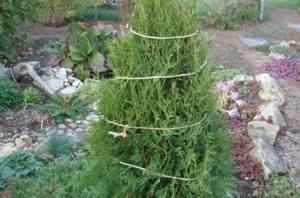
Experienced gardeners recommend covering thuja at the end of autumn, when the weather remains cloudy without precipitation and the air temperature drops no lower than +4 °C. If you prepare the plant for rest without following this rule, then there is a chance that winter will be a difficult test of endurance for your beauty.
Before preparing the thuja for rest, it is necessary to clean the crown of withered needles and carry out routine treatment of the coniferous tree against fungal diseases and pests. This treatment is carried out in two stages, which will protect the plant.











